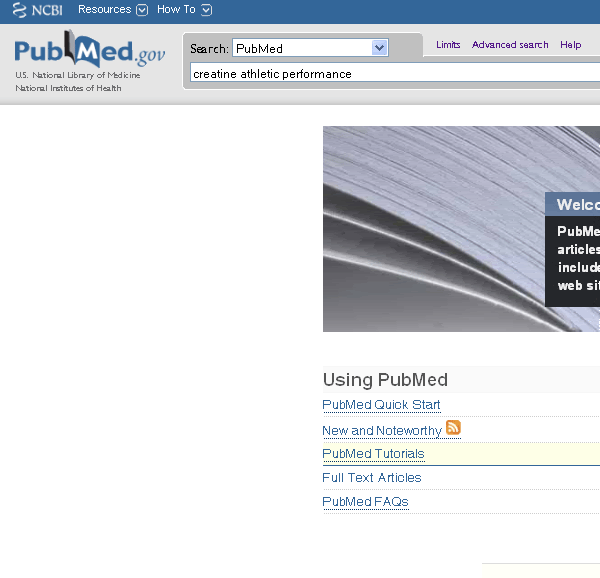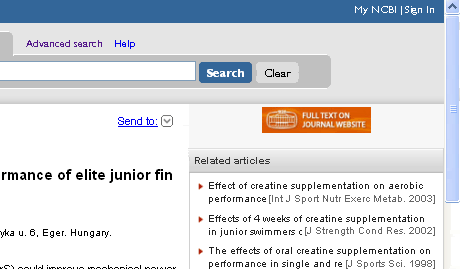Quick Hit Summary
When deciding if a nutritional supplement is right for you, go straight to the research; not some random forum or worse yet, a manufacturer’s website. An excellent resource to research a nutritional supplement (or physiology related inquiry) is Pubmed.gov which contains > 19 million peer reviewed scientific journal articles. If you’ve never used it before, Pubmed can be quite intimidating. However, I’ve created a little tutorial, Pubmed 101, that will hopefully assist you as you make this journey for the first time. One quick warning, do not make a decision based off 1 study alone; rather, base your decision.
Pubmed: A Hotbed for Scientific Research
In a previous article posted on this site (Why Many Supplement Forums and Retail Sites Contain Misinformation), we detailed how internet forums & manufacturer websites are NOT the best place to go when deciding if a supplement will improve performance. Rather, we encouraged you to go straight to the source and research the ingredients of a given supplement at Pubmed. I understand that using Pubmed may seem intimidating at first. However, I hope that the tutorial below will help you get past any sort of fear and allow you to enjoy the use of Pubmed. Enjoy!
Pubmed 101
When you first go to pubmed.gov, the figure below (figure 1) will come up on your computer screen. At the top is the entry box to write in whatever you want to search. I strongly advise you not to research a specific supplement by name (ie- don’t type in Nytric-EFX™ or CGT10™). Very few peer reviewed research studies exist using specific supplements. Rather look at the ingredient list for the supplement and research the specific components of the product. For example, if you’re looking at Nytric-EFX™ research L-arginine, L-arginine AKG. In the case of CGT10™ research creatine monohydrate, L-glutamine and taurine.

Figure 1 Pubmed’s homepage. For the rest of this tutorial, I’ll be using the search terms “creatine athletic performance.” Hence those words in the search box.
If you are a first time user, and learn better via visual demonstrations, I HIGHLY recommend clicking on Pubmed Tutorials. This is listed under the “Using Pubmed” section that can be seen in the bottom right hand quadrant in the above figure. In Figure 1, I have it highlighted a light beige color. Clicking on that section will take you to an area where you can see video demonstrations. You may find the “Searching Pubmed” videos particularly useful.
Once you’ve typed in the search terms “creatine athletic performance“, as seen above in Figure 1, hit “search”. The next screen that comes up should be pretty similar to that seen below in Figure 2. Please note that the images for this article were taken on January 13, 2010. New research is always being published, with the most recent studies being listed at the top of the search results. Thus, the image present in figure 2 may differ from what you see when you type the same search terms into the box and hit “search”.

Figure 2 Pubmed Search Results.
As you can see in Figure 2, using the search terms “creatine athletic performance” brought up 482 peer reviewed studies/articles. Similar to using google.com (or similar type of search engines), you may have to fine tune your search terminology to narrow down results. If you click on any individual study, the next screen that comes up will summarize the study/article. For reference, in the scientific community, the summary of a study/article is referred to as an Abstract. In general, the abstract will tell you the purpose of the study, briefly describe the study’s participants, the treatment (ie- taking creatine, etc), results of the study (usually described statistically), and the conclusions drawn by the researchers of the study. If it’s a review of previous studies, the abstract will be more general. If you’re interested in reading the full study, there will be a link towards the top right hand corner of the screen (just above the Related Articles heading) as seen in Figure 3.

Figure 3 Link for Reading Full Journal Article/Study. PLEASE NOTE The above figure is a slightly out of date image. Now to the left of the “Advanced search” tab, you will now see a “Limits” tab. Look at Figure 1 to see what I’m referring to.
I must inform you, some journals require you to be a subscribing member to read the full article. If you’re getting tired of only being able to read the abstract of a study vs. the entire study, click on Limits which can be found at the top of the screen, just above where you type in your search terms. Once you’ve clicked on this, a screen similar to Figure 4 will show up.

Figure 4 Limits Search Option Screen
As you can see there are many options that can assist you with your search. Under the heading, “Text Options” you can select if you want only free full text articles. Also, notice that you can click on if you want animal based studies or research completed on only humans (which you can also subdivide into male and female). If we click on free full text, and do a search with “creatine athletic performance” in the subject line, a screen similar to Figure 5 should appear. As aforementioned, this is the current screen for this search as of January 13, 2010.

Figure 5 Advanced Search Results when Only Using Free Full Text Articles
On one hand using this advanced search limit (free full text) is nice because you have access to read the entire journal article. On the other hand, there are far fewer journal articles that you can view when you limit yourself to free text only. Since one is able to read the study summary when limits are not used, I recommend looking at BOTH free full text articles AND abstracts of research articles that require a paid subscription (to read entire article).
——————————————————————————————————————————————-
As an FYI, many important study details are obviously missing from abstracts. Therefore, don’t form solid conclusions based off reading only 1-2 abstracts. As far as that goes, in general, one shouldn’t make broad conclusions based off a single study either. Rather, a collection of studies are needed to fully understand if/how a supplement works.
——————————————————————————————————————————————
The first journal article that comes up doing this search is Dietary supplement use by adolescents4. If you click on the journal title, it will take you to a page displaying an abstract as seen in Figure 6.

Figure 6 Abstract of the journal article Dietary supplement use by adolescents.
I’ve already pointed out what you have to do to access the full length article (Figure 4). However, I’d like to direct your attention to the Related articles section which is found on the right hand side of the screen just below the full length article section (Figure 7). As its name implies, listed within this box are similar types of studies.

Figure 7 Related Articles Box
The last thing worth mentioning regarding Pubmed is that you can make a personal account and save any studies that you find interesting. Along the top of the pubmed.gov website there is a blue bar that runs the entire length of the screen. On the right hand side of this blue line are the words “My NCBI” (Please see Figure 8). To start your free Pubmed account, click here. There is also a online video tutorial that cam be accessed on the previously mentioned Pubmed Tutorial section. Look for the videos underneath the “My NCBI Quick Tour.”

Figure 8 Account Sign Up Site for Pubmed
Bottom Line
Do not waste your time reading internet forums or manufacturer websites if you want to see if a product works. Rather, focus on the peer reviewed scientific research when deciding if a supplement is right for you. Luckily, one can access this information at Pubmed.
Hopefully the above tutorial will help you navigate your way through Pubmed. I realize this process can be a pretty intimidating at first. However, get these steps down and you’ll have Pubmed mastered. Let your researching career begin!!!
Nytrix-EFX™ is a trademark or registered trademark of All American EFX.
CGT10™ is a trademark or registered trademark of Optimum Nutrition.
